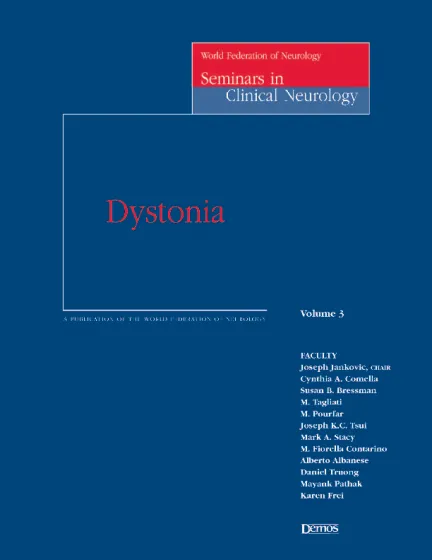Document Download: Dystonia

Description:
Our third course addresses the important area of management of the dystonias. The Chair of this course, Professor Joseph Jankovic, a recognized international authority, has selected an outstanding faculty of experts. We very much welcome your comments and advice for future courses.
Released: 4 Dec 2007
Published: 8 Jul 2016
Preface
Dystonia is a neurologic disorder characterized by involuntary, sustained, patterned, and often repetitive muscle contractions of opposing muscles that cause twisting movements, abnormal postures, or both (1). One of the earliest descriptions of dystonia was provided in 1888 by Gowers, who used the term "tetanoid chorea" to describe the movement disorder in two siblings who were later diagnosed to have Wilson's disease. The term "dystonia musculorum deformans," coined by Oppenheim in 1911, was criticized for several reasons: fluctuating muscle tone was not necessarily characteristic of the disorder; the term "musculorum" incorrectly implied that the involuntary movement was due to a muscle disorder; and not all patients became deformed. More recently, the term "torsion dystonia" has been used in the literature, but since torsion is part of the definition of dystonia, this term seems redundant. Hence, the simple term "dystonia" is currently preferred and used to describe the phenomenology of this movement disorder. When used to describe a disease, it should be prefaced as either primary (without any associated neurologic deficit; it may be idiopathic or genetic) or secondary (caused by a variety of etiologies such as brain insult, certain drugs, and a variety of heredodegenerative disorders).
The primary objective of this seminar is to provide a practical review of dystonia that emphasizes cost-effective evaluation and treatment. This should be of particular value to physicians in developing countries who have limited diagnostic and therapeutic resources. Maintaining this focus is challenging in view of the increasing dependence on the latest imaging, genetic, and other technologies to evaluate patients with neurologic disorders. Furthermore, there is growing emphasis on evidence-based medicine to select only treatments that have proved efficacy and safety. However, these treatments may not be readily accessible in developing countries. For example, until recently pallidotomy, rather than medication, was the preferred treatment for Parkinson's disease in some countries, as the cost of surgery was less than long-term treatment with levodopa or dopamine agonists. A more relevant issue with respect to dystonia is the use of botulinum toxin, considered the treatment of choice for many focal or segmental dystonias (2). While relatively costly, this treatment has such important beneficial impact on the function, productivity, and quality of life of the affected individual, as demonstrated by many well-designed studies, that it may be cost-effective even in the setting of limited resources.
The contributors to this seminar have addressed these issues and balanced the advantages of the latest technologies and treatments against the practicality of the "real-world" situation facing health care providers in developing countries as they evaluate patients with dystonia and related movement disorders. I believe that the result is a collection of scholarly and, at the same time, practical reviews.
I am grateful to the authors for sharing their expertise and for providing excellent material. I also would like to thank Ted Munsat, MD for inviting me to chair this seminar and for having the confidence that the authors I selected would meet the challenge. Finally, I would like to express my appreciation to Dr. Diana M. Schneider for her constant encouragement and guidance.
Joseph Jankovic, MD
-
Jankovic J, Fahn S. Dystonic disorders. In: Jankovic J, Tolosa E, (eds.) Parkinson’s Disease and Movement Disorders. 4th ed. Philadelphia, PA: Lippincott Williams & Wilkins. 2002:331–357.
-
Jankovic J. Botulinum toxin in clinical practice. J Neurol Neurosurg Psychiatry. 2004;75:951-957.







